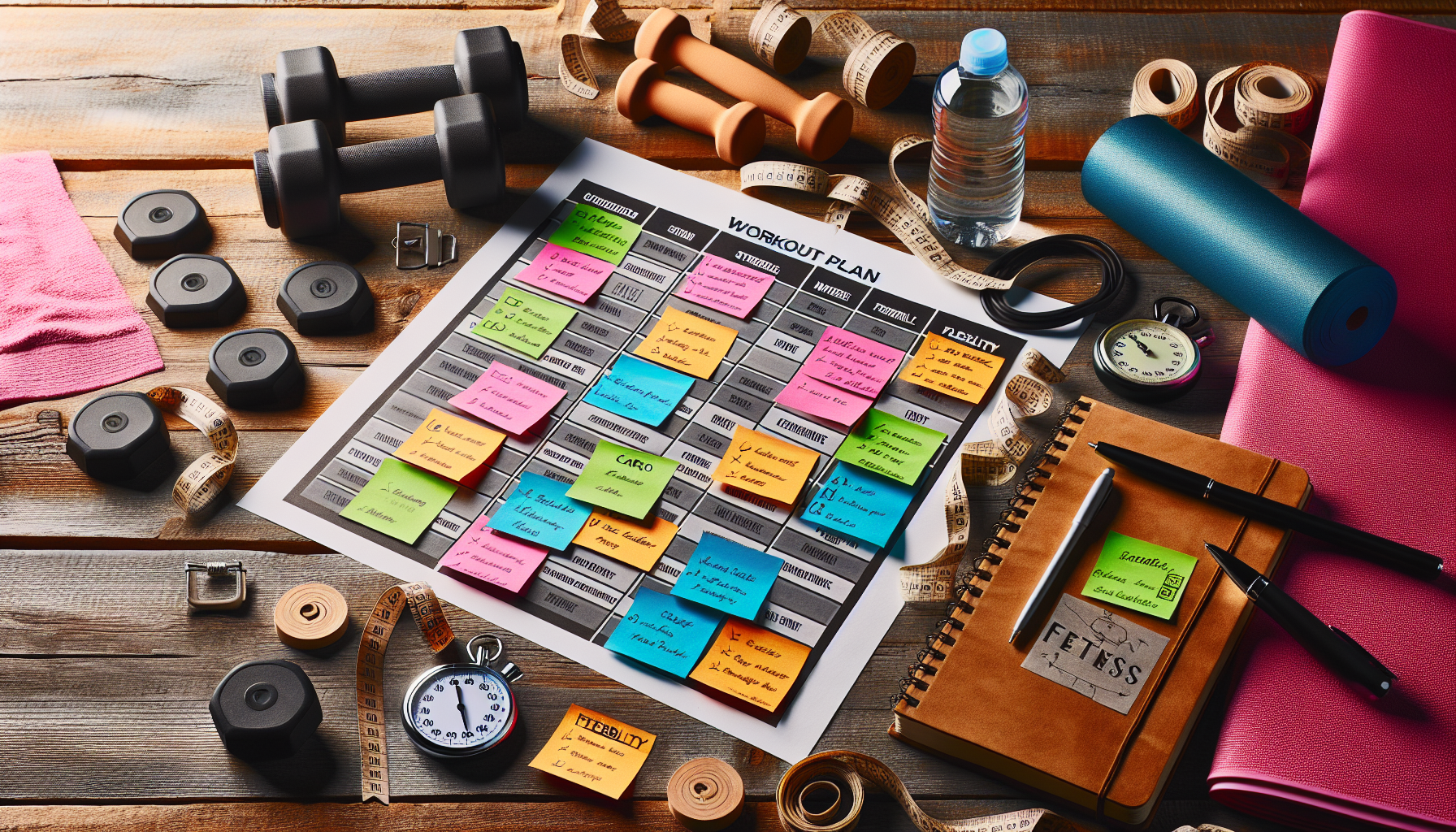What if you could design your own weekly workout plan that not only fits into your busy schedule but also actually delivers the results you desire? Creating an effective workout regimen can seem like a daunting task, especially if you’re not sure where to start. Fortunately, with a few simple steps, you can craft a plan that works for you and your fitness goals.
Understanding Your Fitness Goals
Before jumping into creating your workout plan, it’s crucial to identify your fitness goals. Whether you want to lose weight, build muscle, improve endurance, or just maintain a healthy lifestyle, knowing your objective will inform the types of workouts you should incorporate.
Identify Your Objectives
Ask yourself what you want to achieve. Are you trying to:
- Lose weight?
- Build muscle?
- Increase flexibility?
- Improve cardiovascular fitness?
You may have one primary goal or a combination of a few. Once you know what you want to achieve, you can choose appropriate workouts that align with your objectives.
Assess Your Current Fitness Level
Evaluating your current capabilities is vital for setting realistic goals. Are you a beginner who hasn’t worked out in a while, or are you relatively active? Keeping this in mind allows you to tailor your plan effectively.
Establishing a Workout Schedule
Building a workout schedule that fits into your lifestyle is essential for sustainability. Consistency is key to earning the results you’re looking for.
Choose the Right Frequency
Consider how many days a week you can commit to working out. A good starting point is:
- 3 days a week: Ideal for beginners or those with busy schedules.
- 4-5 days a week: Good for those looking to up their game and see faster results.
- 6-7 days a week: Suitable for advanced fitness enthusiasts or competitive athletes.
Time Management
You may feel overwhelmed by the thought of slashing hours out of your busy week to work out. Thankfully, even a 20-30 minute workout can yield impressive results. Choose times that fit seamlessly into your day, like early mornings before work or during your lunch break.

Choosing the Right Exercises
Once you have established your goals and schedule, it’s time to select your workouts. This section includes suggestions for different types of exercise that can cater to a range of goals.
Cardio Workouts
If your main goal is weight loss or improving heart health, incorporating cardio workouts into your plan is crucial. Here are a few options to consider:
- Running or Jogging: Great for burning calories and improving cardiovascular health.
- Cycling: Low-impact alternative that is easier on your joints.
- Jump Rope: A fun and challenging workout that can be done at home.
- HIIT (High-Intensity Interval Training): These workouts alternate between intense bursts of activity and short recovery periods, ideal for burning fat quickly.
Strength Training
Building muscle is another vital part of any workout plan. Consider integrating strength training exercises:
- Bodyweight Exercises: Push-ups, squats, and lunges can all be done without equipment and target multiple muscle groups.
- Free Weights: Dumbbells and kettlebells allow you to gradually increase resistance as you get stronger.
- Resistance Bands: Portable and versatile, resistance bands can provide an effective strength workout anywhere.
Flexibility and Core Workouts
Balancing strength and cardio with flexibility and core workouts is critical for overall fitness and injury prevention. You might want to include:
- Yoga: Excellent for enhancing flexibility and mental balance.
- Pilates: Focuses on core strength while improving flexibility.
- Stretching Routines: Simple stretches can enhance mobility and aid in recovery post-workout.
Structuring Your Weekly Workout Plan
Now that you know your objectives, schedule, and exercises, let’s put everything together into a structured weekly workout plan.
Sample Weekly Workout Plan
Here is a simple framework you could follow. Feel free to modify it according to your preferences and fitness level:
| Day | Focus | Activity |
|---|---|---|
| Monday | Strength | Full-body workout (bodyweight or weights) |
| Tuesday | Cardio | 30 minutes of running or cycling |
| Wednesday | Flexibility | Yoga or Pilates session |
| Thursday | Strength | Upper body workout |
| Friday | Cardio | HIIT session |
| Saturday | Active Rest | Light activity like walking or stretching |
| Sunday | Strength | Lower body workout |
Adjusting Your Plan
You may start with this framework, but it’s important to adjust it based on how your body feels. If you are too sore to perform your planned workout, consider switching in a recovery day or lower-intensity activities. The objective is to listen to your body and make adjustments as needed.

Incorporating Rest and Recovery
Many individuals overlook the power of rest days, but they are crucial for your body to recover and become stronger.
Importance of Rest
Rest allows your muscles to repair and grow after workouts, preventing overtraining and injuries. Depending on your schedule, you should incorporate at least one full rest day per week.
Active Recovery
Active recovery can be just as beneficial. Instead of doing nothing, consider engaging in low-impact activities on your rest days, like:
- Walking
- Gentle yoga
- Stretching
Monitoring Your Progress
Keeping track of your progress will not only motivate you but also give you tangible evidence of improvement. Find ways that work for you to measure your results.
Tracking Tools
You can utilize smartphones, fitness apps, journals, or even a simple spreadsheet. Monitor:
- The weights you lift
- Your cardio times
- Changes in your body measurements
Setting Milestones
Establish short- and long-term goals for yourself to give your journey structure. For instance, every month, aim for a new personal record in your main exercises.

Staying Motivated
Creating your workout plan is just the beginning. Staying motivated is critical for continued success, and here are some tips to help:
Find an Accountability Partner
Having a workout buddy can make exercising more enjoyable and keeps you accountable. You can encourage each other on tough days and celebrate achievements together.
Mix It Up
Don’t fall into a monotonous routine. Change up your workouts every few weeks to challenge your body and keep things fresh. Experiment with new exercises, classes, or outdoor activities.
Reward Yourself
Set milestones and reward yourself when you achieve them. This can be in the form of new workout gear, a massage, or a day off to do something fun.
Nutritional Support
While exercise is essential, nutrition plays a complementary role in achieving your fitness goals. The right diet can fuel your workouts and aid recovery.
Understand Your Needs
Consult with a nutritionist to determine your dietary needs based on your fitness goals. Generally, ensure you’re getting a balance of:
- Proteins: Essential for muscle repair and growth.
- Carbohydrates: Your body’s primary energy source.
- Fats: Important for hormone regulation and overall health.
Pre- and Post-Workout Nutrition
what you eat before and after your workouts is crucial for performance and recovery. Consider:
- Pre-Workout: A small meal or snack with carbs and protein about 30 minutes before exercising can provide energy.
- Post-Workout: Consuming a protein-rich meal within an hour after your workout aids in muscle recovery.

Making Adjustments
As you follow your plan, be prepared to make adjustments. Life can be unpredictable, and being flexible is essential to staying on course.
Reassess Regularly
Check in with your fitness goals every few weeks and adjust your workout plan as necessary. This could mean increasing workout intensity, switching activities, or altering your timing.
Listen to Your Body
Pay attention to how your body responds to your workouts. If you feel constant fatigue or experience pain, it might mean you need more rest, less intensity, or a different exercise altogether.
Conclusion
Creating a weekly workout plan that delivers results is about more than just picking exercises. It requires a thoughtful approach to setting goals, scheduling workouts, and ensuring recovery. By understanding your fitness objectives, choosing the right activities, and monitoring your progress, you can establish a routine that works for you. The journey is yours to customize, so embrace the challenge and enjoy the rewards that follow! Keeping everything friendly and enjoyable can not only lead to results but also help cement healthy habits that last a lifetime.










